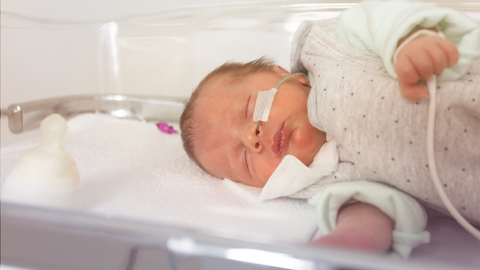New surfactant could improve lung treatments for premature babies
Scientists have developed a new lung surfactant that is produced synthetically rather than relying on the use of animal tissues. With further development, the formulation could provide a cheaper and more readily available alternative to Infasurf, a medication used to prevent and treat respiratory distress in premature babies.
Surfactants are substances that decrease surface tension where liquids interface with other liquids, gases or solids. In addition to their use in medicines, they are found in a wide range of products including detergents, cosmetics, motor oils and adhesives.

Suzanne Farver Lukjan, a lecturer in chemistry at Troy University in Alabama, led the work.
“A synthetic surfactant could potentially have a longer shelf life, lower production costs, have less batch variability and pose less risk of an immune response compared to animal-derived lung surfactants,” she said. “We hope our formulation will one day be used in hospitals.”
Lukjan will present the research at Discover BMB, the annual meeting of the American Society for Biochemistry and Molecular Biology, which is being held March 23–26 in San Antonio.
Lung surfactants help premature babies breathe while their lung cells finish developing. In addition to offering a potential alternative to replace Infasurf for babies, researchers say the new synthetic surfactant could be useful for treating adults with lung injuries as a result of diseases such as chronic obstructive pulmonary disorder, miner’s lung or emphysema.
Researchers have previously attempted to develop synthetic lung surfactants, but some have been removed from the market and others have not been able to lower surface tension as well as animal-derived formulations.
In the new work, Lukjan’s team created candidate surfactants from synthetic lipids (fats) and peptides (short chains of amino acids) and then tested their surface-tension-lowering capabilities. They aimed to mimic the composition, lipid phase behavior and biophysical function of Infasurf as closely as possible.
After tweaking a step in the sample preparation process, the researchers found a few formulations that showed particular promise. Although tests demonstrated that the chemical behavior of the synthetic surfactants was quite different from that of Infasurf, the new surfactants were able to mimic the drug’s functionality in terms of lowering surface tension and seem to achieve the optimal range in terms of peptide concentration.
As a next step, Lukjan said, the group plans to continue to refine and test their formulation to further optimize the combination of lipids and peptides. The surfactant would also need to undergo safety testing before it could be used clinically.
This work was partially funded by ONY Biotech Inc., maker of Infasurf.
Suzanne Lukjan will present this research from 4:30 to 6:30 p.m. CDT on Monday, March 25, in the exhibit hall of the Henry B. González Convention Center (Poster Board No. 210) (abstract).
Enjoy reading ASBMB Today?
Become a member to receive the print edition four times a year and the digital edition monthly.
Learn moreGet the latest from ASBMB Today
Enter your email address, and we’ll send you a weekly email with recent articles, interviews and more.
Latest in Science
Science highlights or most popular articles

Mining microbes for rare earth solutions
Joseph Cotruvo, Jr., will receive the ASBMB Mildred Cohn Young Investigator Award at the ASBMB Annual Meeting, March 7–10, just outside of Washington, D.C.

Fueling healthier aging, connecting metabolism stress and time
Biochemist Melanie McReynolds investigates how metabolism and stress shape the aging process. Her research on NAD+, a molecule central to cellular energy, reveals how maintaining its balance could promote healthier, longer lives.

Mapping proteins, one side chain at a time
Roland Dunbrack Jr. will receive the ASBMB DeLano Award for Computational Biosciences at the ASBMB Annual Meeting, March 7–10, just outside of Washington, D.C.

Exploring the link between lipids and longevity
Meng Wang will present her work on metabolism and aging at the ASBMB Annual Meeting, March 7-10, just outside of Washington, D.C.

Defining a ‘crucial gatekeeper’ of lipid metabolism
George Carman receives the Herbert Tabor Research Award at the ASBMB Annual Meeting, March 7–10, just outside of Washington, D.C.

The science of staying strong
Muscles power every movement, but they also tell the story of aging itself. Scientists are uncovering how strength fades, why some species resist it and what lifestyle and molecular clues could help preserve muscle health for life.

